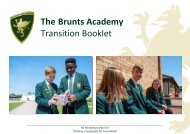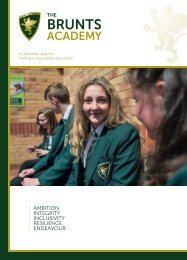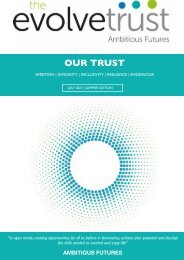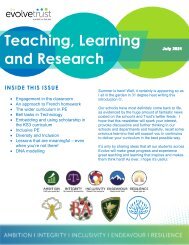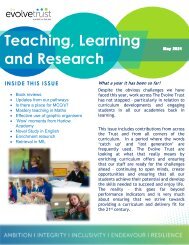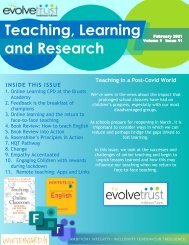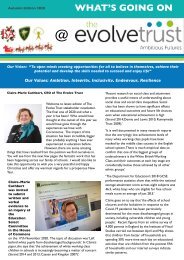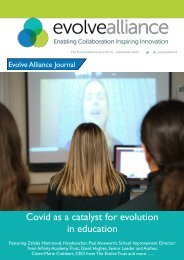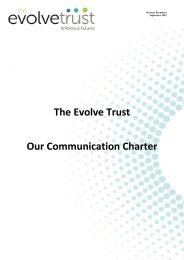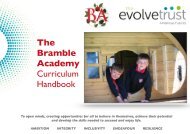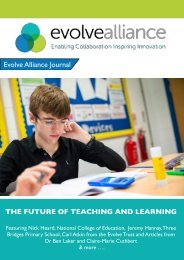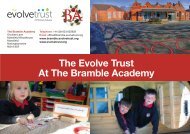Summer 1 Teaching and Learning Newsletter
Create successful ePaper yourself
Turn your PDF publications into a flip-book with our unique Google optimized e-Paper software.
Teaching, Learning
and Research
INSIDE THIS ISSUE
1. Book Club moves online
2. Embracing literacy in your subject
3. Online PLD
4. Online Teacher Recruitment
5. CRAFT by Michael Chiles: Book
Review
6. Engaging Parents During School
Closures
The big shift to online provision
and recruitment
In this issue, we look at how the online book
club and PLD opportunities have had a
fantastic uptake, and the impact it is having on
the professional practice of staff from across
the Trust.
Also, Natalie Aveyard shares her thoughts on
The Evolve Trust’s adaptation to its
recruitment strategy in light of the COVID-19
pandemic. Natalie’s experiences have been
published on the TES.
Finally, this issue looks at the potential
challenges of engaging parents during school
closures and features an article written by
Janet Goodall for the Chartered College of
Teachers’ Journal ‘Impact’.
The Book Club moves online By Joe Morrin Page 2
On Monday, the book club members
reviewed Kate Jones’ ‘Love to Teach’ on
Teams. This session, we looked at the
concept of literacy; the importance and the
ways we support it in our subject areas. We
also discussed how literacy in our respective
subjects supports other subjects and
whether or not there are opportunities to
develop this through the use of joint
planning; subject-specific dictionaries and
book clubs.
potential and to participate effectively in
society’ (OECD, 2000 cited in Jones, 2018).
Furthermore, the session looked at the
challenges of the quality of student written
work and highlighted the potential
drawbacks of rushed work, as well as
strategies we use to get students to review
the quality of written work, which included
drawing upon the work from Austin’s
Butterfly.
During the session, we discussed the
importance of reading as an invaluable skill
for our students and that this needs to be
completed in the early years and supported
throughout schooling and home life, so they
can access the curriculum and achieve their
goals. Alternatively, as the OECD (2000) puts
it, it is ‘the ability to understand, use and
reflect on written texts in order to achieve
one’s goals, to develop one’s knowledge and
Overall, this was a brilliant session with
very insightful suggestions. The range of
perspectives from staff working across
different phases and subject areas
challenged our way of thinking. It posed
questions on how we can adapt our
pedagogy in light of the critical discussion.
There are lots of new approaches we can
try out and discuss when we return in
Summer 2 to look at ‘Vocabulary
instruction and confidence with keywords’.
Embracing Online PLD literacy in your subject:
A reflection of Kate Jones’ book
By David Irons
Page 3
In terms of Chapter 4 if we were still in
school I’d definitely try the speeding ticket
idea. It’s a big issue in Humanities that
students often give very short and
unsupported answers. A good example was
this year when we had a source question for
Year 9 that had a Nazi schoolbook
illustration and a series of questions such as
“How can we tell the Jewish man is the bad
character in the book?” what we hope for is
a detailed explanation of the Jewish
stereotype by the Nazi’s but often you’d get
an answer like “He looks bad” when in
reality you want them to write in a
complete sentence and give supporting
evidence. The main reason I think is
because perhaps in History where we often
require longer answers and students see a
time limit they think they’re going to
struggle. I think the speeding ticket would
help students slow down and take more
time to include the details in their work. I
like what the book says about it reinforcing
the idea that you don’t see just finishing
work as a reason for praise that it needs to
be of a good standard and thus reinforces
expectations of good quality work.
I wasn’t so keen on the SPaG watch idea as
I think it may take more “Training” for the
students than many of the other ideas. I
think though for a subject like say English
that have many more teaching hours a week
its an excellent tool. I just think with an
hour a week I’d struggle to get students
trained to where this is a normal activity as
it may be many weeks between us using it.
I can also see how it may be useful for say
PP or GT students by engaging them in a
different way. Alternatively it would be
something that if it was done across a whole
school could be very effective.
From my own experiences I agree with her
about popcorn reading. I’m not a fan as I
see students not taking it seriously and too
busy worrying about when it will be there
turn rather than focusing on what the
meaning of what is being read is. I like the
idea of giving students some prior time
with text though. I’ve often used the “Ok
two minutes scan read it and highlight any
words you don’t understand” approach
before going through sources as a class. I
also liked the book club idea and think it
can link brilliantly to History, for example
when we look at the World Wars we could
recommend Warhorse and even perhaps
have a postcard drop box for students
who’ve read it to do a little task such as
how does the work of fiction relate to the
facts they’ve learnt.
I like some of the ideas she talked about in
speaking and listening. Sadly it was very
tech heavy, not something I’ve ever been
blessed with in a school, the ideas though
could work well. I’ve once done a newsroom
lesson on Dunkirk where I had students
producing a newspaper but drip feeding
them information verbally. So for example
the lesson started off with an official
government announcement. Five minutes
later they could interview an officer from
the Navy and ask questions. Ten minutes
after that they got an interview with
Churchill etc. Students enjoyed the lesson
but it was kind of chaos, however I suspect
real life news rooms are pretty similar so
maybe a good simulation.
Using Technology Across the
Trust
Page 4
During the COVID outbreak many staff from across the Trust have been engaging with a variety of PLD
opportunities available on numerous platforms, such as Seneca Learning, Teach Meets, ResearchEd
sessions, Spotify. It has been fascinating to hear staff feedback about their PLD at home and how it has
shaped their professional practice. Below are just some of the experiences shared by the staff.
Iain Hickman – Science
Firstly, I’ve done a lot on Seneca and here
is a link to all the resources that have
supported those sessions, which may be
useful for faculty teams, some of them
relate to memory and retrieval, which
with the linear exam structure we now
have has never been more important.
https://drive.google.com/drive/folders/1
396JpnPfmZ9QBAy8qWj_eLvVYdISOc2r
Secondly, I discovered last night whilst
choosing something other than Running
Podcasts to listen to on SPOTIFY, was
there anything on there for Professional
Development. So, I searched teacher
professional development, and there was
a wealth of podcasts available to listen to.
Also on the podcasts there were GCSE
revision for Science available I’m
therefore assuming there should be other
subjects also available – not looked into it
yet, but I will be giving some a listen and
if I think they are ay good I will be
recommending them to my Y10 students
as another platform to access work during
this school lock down period.
Lastly, this one is purely Science
(Chemistry) related but I’ve shared with
the Brunts Science Staff team materials
from an educator called Adam Boxer, who
seems to specialise in memory and
retrieval approaches and there are some
great materials on his website and what’s
even better they are all FREE.
Helen Taylor - Maths
I’ve spent a fortune on books since we’ve
been in lockdown. My latest three were:
1. Making every maths lesson count –
Emma McCrea – there is a series of
these books for each subject area –
this was fantastic for maths,
wonder if they are as good for other
faculties too?! – links to CPD we
have been focussing on all year ☺
2. Teach like nobody is watching – this
was your recommendation – I’ve
already used it when planning some
CPD for the NQTs.
3. Making Good Progress – Daisy
Christodoulou - again, linked this
into some of the CPD sessions I have
planned.
Online Teacher Recruitment: Natalie
Aveyard features in the TES
By Gemma Corby
And Natalie Aveyard
Page 5
This is an extract from the TES article available
at: https://www.tes.com/news/recruitment-itbusiness-usual-again-schools
It will come as no surprise that recruiting
teachers, in the current climate, presents
some challenges.
Fortunately, schools are innovative places,
and many have found ways around the
issues. Here we speak to three senior
leaders about their experiences of
recruiting during the coronavirus
lockdown.
Natalie Aveyard is deputy headteacher at
The Brunts Academy, which is part of The
Evolve Trust in Nottinghamshire. Her
school has managed to successfully recruit
staff, despite the lockdown.
“At the Trust we make it clear prior to the
interview that the day will be made up of
a number of tasks, but we do not specify
details at that stage,” says Aveyard.
Tasks set by The Evolve Trust, depending
on the role, include:
Preparing a lesson plan in 30 minutes – with
the topic being given there and then.
Candidates are required to explain their
plan and answer any questions. Critiquing
a videoed lesson, sent via a link on the day.
Analysing an article, also sent to
interviewees on the day.
Aveyard says that The Brunts Academy,
where she is based, has had candidates
withdraw once the schedule has been sent
out as they realise that the process will still
be rigorous despite lockdown.
“It is not just a 20-minute phone interview,
which I know some schools have done – I
think the rigour of our process has put
some people off in terms of the work that
it will entail. We’re fine with this, as we
want the right candidates who are also
comfortable with our culture and
approach,” she says.
So far, so good. But what are the downsides
to this otherwise rigorous process?
One of the difficulties of setting tasks
remotely is that candidates can draw on
other resources, which they are less likely
to be able to do if the interview is taking
place in person. This is something Aveyard
has experienced.
“Obviously it is up to them whether ‘they
call a friend’, so to speak. Only on one
occasion have we had a candidate submit a
lesson plan that was obviously not planned
by themselves, as upon further questioning
they were not able to articulate why they
had chosen certain activities," she says.
"This was not in line with the values of the
Trust and therefore this candidate clearly
didn’t progress to the next stage."
Despite this downside, remote recruiting
has been working well for Aveyard and her
colleagues across The Evolve Trust.
“Being able to see a candidate and look
them in the eye (albeit via a computer
screen) is crucial," Aveyard says.
"We feel confident that we are overcoming
the obvious challenges and that our
processes are still in line with safer
recruitment.
"We are testing for the necessary skills and,
above everything, ensuring that the
candidates are a values-match and that
they have the information they need to
make the right choice for them, too.”
CRAFT by Michael Chiles: Book
Review
By Joe Morrin Page 6
CRAFT is a brilliant book for teachers at any stage of their career. This book looks at the
discussions that surround the most effective process of assessment and feedback, which has been
a topic of significant debate in many schools in recent years. Michael Chiles is a Geography
Teacher and Principle examiner. Besides, he is strongly passionate about a whole-school approach
to assessment, which is the main reasons why I decided to buy this book.
Similar to most books published by John Catt., there is a significant overlap of ideas from other
books from the same publisher, for example, retrieval practice, Rosenshine, the Ebbinghaus
Forgetting Curve and lesson strategies. Nonetheless, there are some significant golden nuggets
of brilliance. Initially, I thought this book would all be about assessment, but Chiles examines
the process in the lead up to assessment and what constitutes an adequate assessment of
learning. Notably, are we training our students enough to apply themselves during an assessment
effectively?
Chiles provides a journey through the assessment process by breaking the book down into five
sections based upon the book’s title, ‘CRAFT’:
Chapter 1 looks at the ‘C’ in ‘Condense’ and addresses ways in which we can condense knowledge
effectively and how teachers can support this so that pupils take ownership of their learning.
Chapter 2 is the ‘R’ in ‘Reflect’. How can students being better reflective learnings and how can
teachers provide opportunities inside and outside of the classroom to strengthen memory and aid
recall.
Chapter 3 is the ‘A’ in ‘Assess’ and provides the debate about assessment. This chapter also looks
at how levels have distorted the real value behind the role of assessment for learning and provide
ways in which teachers and pupils can develop a deeper understanding of what students know;
what they need to know and how they can get there.
Chapter 4, is the ‘F’ and ‘T’ in ‘Feedforward’ and ‘Target-Driven Improvement’ which draws upon
research-based evidence to assess the use of feedforward and feedback strategies and how to
provide practical, positive and specific targets to close knowledge gaps.
The final chapter looks at ways in which we can support colleagues through the use of
instructional coaching to support teachers with the implementation and the review of effective
strategies to develop their CRAFT of teaching.
Throughout the book, Chiles uses case studies from a range of schools and teachers to reinforce
the practical aspects behind the theory and to explain how different strategies can be applied in
a range of different contexts. These teachers include. Sam Strickland, Zoe Ensor, Aiden Seven
and Dr, Flavia Belham (Seneca Learning). A very worthwhile read.
Engaging Parents During School
Closures
By Janet Goodall ‘
Page 7
Teachers and other school staff face new challenges during this extraordinary time, as they support families
at home. This article aims to provide some support and advice around these unique challenges, drawing on
a range of research about parental engagement, but should also provide insight for work in schools far
beyond the present circumstances.
Homes, not classrooms
The first thing to say is that these are extraordinary times, and we shouldn’t be trying to recreate
classrooms at home, or recreate the same style of learning at home that would generally happen in the
classroom – first, because it’s simply impossible, and second, because it wouldn’t work.
Homes are, in general, not classrooms and rarely contain the numbers of children that inhabit most
classrooms. School settings have evolved to be efficient (more or less) in providing education to groups of
children – groups who are gathered together by age, rather than by being members of the same family.
Although a good many teachers are parents, most parents are not classroom teachers, and we’re not going
to turn them into classroom teachers overnight – and we shouldn’t be trying to. That’s not what their
children and young people need at the moment.
In teaching, writing and presenting over the last 10 years or so, I’ve often asked school leaders to consider
what’s really important in schooling – to think about what schools are for, and to concentrate on that.
Schools were originally set up to enable groups of children to learn the things that society deemed were
important for them to know (Goodall, 2017), and have come a very long way in being able to do that,
mainly through the dedication and professionalism of the staff within the school walls.
Now, though, we need to get back to those basics, to become radical if you like (the word means ‘root’) –
what’s really important for our children to learn? To do, to be, to become?
And how can we help families support that learning? Now, more than ever, we need to see growing
partnerships between school staff and other families – and I say ‘other’ because one facet of the whole
debate that seems to be ignored is just how many school staff are themselves parents or carers…
The value of parental engagement
Research has shown the value of parental engagement for many years – the more that parents are involved
with learning, the more that children attend school, the more that homework is done, the more that
behaviour improves and children achieve more; there’s more than enough evidence to show this (Fan and
Chen, 2001; Fan and Williams, 2010; Hornby, 2011; Jeynes, 2012, 2014, 2018).
But it’s important to understand what ‘parental engagement with learning’ actually means – it doesn’t
mean coming into school, and it doesn’t necessarily mean checking on homework (and it never has);
effective parental engagement with learning means the attitude towards and support for learning in the
home (Goodall and Montgomery, 2014). So supporting parental engagement isn’t about just giving young
people more homework or worksheets; it’s about ensuring that young people have the best opportunities
for learning that we – as a society – can provide. (And I would argue that that should always have been the
point of homework, anyway (Goodall, 2020)).
Parents (those who are not teachers already) are not going to turn into professional teachers overnight
(consider how much training you had before you stepped into the classroom and how much you’ve
continued to learn since that first day!). We need to stop thinking about ‘what we would have done if they
were still in school’ and start thinking about ‘how we can support learning now that they’re not in school’.
Engaging Parents During School
Closures
By Janet ‘ Goodall Page 8
Supporting families to support learning
We also need to realise that not all families will have everything we might like them to have, and not
taking account of that could further disadvantage some of our most vulnerable students.
Many families won’t have enough devices for all children and adults in a family to work at the same time
– asynchronous support for learning, where possible, is a good option. Not all families will have a ready
store of Playdough, Lego or paper plates… we need to think creatively about supporting learning in
different situations. For many of us, this was one of the reasons why we wanted to be in education in
the first place, to facilitate learning wherever and whenever we could – if we can, this is a time to
recapture that creativity.
Many parents are very concerned about being able to support their children’s learning, particularly for
older children; parental lack of self-confidence was a barrier to engagement in learning long before
COVID-19. Early on in your communication with families, it would be useful to let parents know your
stock answers to ‘Miss/Sir, I can’t do this!’ You know the answers: ‘You can’t do it yet!’, ‘Okay, how do
you think you can find out how to do it?’, etc. Share these with parents – let parents know that it’s okay
not to know the answers, as long as the search continues.
This is not, as I’ve said, a normal time. Many families will be experiencing grief and loss; most of us are
worried about loved ones, particularly when separated. Trying to carry on as though nothing is different
is simply not going to work. We need to acknowledge the fear, the grief and the lack of time, equipment,
training and resources facing families as they try to support learning.
I’ve said that we need to start from the basics, from the root, and the basics here are that everyone
involved wants what’s best for the child: you, the parents, other family members. We need to be working
with families to provide that ‘best’.
‘Best’ is not synonymous with ‘everything’ – not everything can be the best. Think about what’s really
important – what do your students really need to know, to be able to do? What can be left aside for now?
Approach creating materials for family learning as you would any other teaching material: start from the
endpoint and work backwards, to how to arrive there. And please, let parents know that you’re not
expecting them to be professional teachers: you’re hoping that they will support (not necessarily even
lead) their children’s learning, with your help.
The past, the present and the future
Teachers, parents, local authorities and government bodies are all trying to make this work for children.
No one knows what the long-term effects will be. I’m hoping that one outcome will be that many parents
are far more connected with their children’s learning than they had been in the past, and that the
partnerships between teachers and families that are being created and strengthened now will continue.
We won’t walk back into the same classrooms, with the same young people, as the same teachers: we’re
all being changed by the pandemic. But it’s not about the classroom or the school – but then, it never
was. It’s always, fundamentally, been about the learning.




